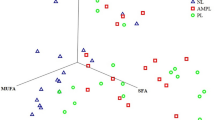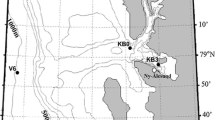Abstract
The neutral and polar lipids of the Galatheidae vent crab, Shinkaia crosnieri, with its eggs were studied to assess its lipid physiology and trophic relationship at hydrothermal vents. The vent crab obtained many of its lipids from Bathymodiolus mussels and chemosynthetic microorganisms which live on a mat of long, silky setae on the crab body as exosymbionts. In all lipid classes, the major monounsaturated fatty acids were 16:1n-7 and 18:1n-7, which originate from bacteria. The major polyunsaturated fatty acids (PUFA) in the triacylglycerols were 16:2n-4, 18:2n-4, 18:2n-7, 18:3n-4,7,10, and 16:2n-3, while those of the crab polar lipids were 16:2n-4, 18:2n-4, 18:3n-4,7,10, 20:4n-6 (arachidonic acid), 20:5n-3 (icosapentaenoic acid), and 22:6n-3 (docosahexaenoic acid) in the phosphatidylethanolamine, and 16:2n-4, 18:2n-4, and 18:3n-4,7,10, with noticeable levels of 20:4n-6, 20:5n-3, and 22:6n-3 in the phosphatidylcholine. In the crab and its eggs, TAG and phospholipid PUFA consisted primarily of n-4 family (n-4 and n-7) methylene-interrupted PUFA with n-3 and n-6 PUFA. The unique fatty acid composition mix of n-3, n-4, and n-6 PUFA in S. crosnieri lipids suggests the vent crab utilizing chemosynthetic bacteria, which produce both unusual n-4 and normal n-3 and n-6 PUFA. Such unique fatty acid composition differs from that reported for other common marine animals, which depend on organic matter derived from phytoplankton lipids.










Similar content being viewed by others
Abbreviations
- ARA:
-
Arachidonic acid
- DHA:
-
Docosahexaenoic acid
- DMA:
-
Dimethylacetals
- DMOX:
-
4,4-Dimethyloxazoline
- EPA:
-
(E)icosapentaenoic acid
- GC–MS:
-
Gas chromatography–mass spectrometry
- MUFA:
-
Monounsaturated fatty acid
- NMR:
-
Nuclear magnetic resonance
- PC:
-
Phosphatidylcholine
- PE:
-
Phosphatidylethanolamine
- PUFA:
-
Polyunsaturated fatty acids
- TAG:
-
Triacylglycerols
- TFA:
-
Total fatty acids
References
Ackman RG (1989) Fatty acids. In: Ackman RG (ed) Marine Biogenic Lipids, Fats, and Oils, vol I. CRC Press Inc, Boca Raton, pp 103–137
DeLong EF, Yayanos AA (1986) Biochemical function and ecological significance of novel bacterial lipids in deep-sea procaryotes. Appl Environ Microbiol 51:730–737
Yano Y, Nakayama A, Saito H, Ishihara K (1994) Production of docosahexaenoic acid by marine bacteria isolated from deep sea fish. Lipids 29:527–528
Saito H, Seike Y, Ioka H, Osako K, Tanaka M, Takashima A, Keriko J, Kose S, Souza JCR (2005) High docosahexaenoic acid levels in both neutral and polar lipids of a highly migratory fish: Thunnus tonggol Bleeker. Lipids 40:941–953
Ackman RG (2000) Fatty acids in fish and shellfish. In: Chow CK (ed) Fatty acids in food and their health implications, 2nd edn. Marcel Dekker, New York, pp 47–65
Arts MT, Ackman RG, Holub BJ (2001) “Essential fatty acids” in aquatic ecosystems: a crucial link between diet and human health and evolution. Can J Fish Aquat Sci 58:122–137
Raymont JEG (1983) Vertical migration of zooplankton. In: Raymont JEG (ed) Plankton and productivity in the oceans, vol 2, 2nd edn. Pergamon Press Ltd, Elmsford, pp 489–524
Dalsgaard J, St John M, Kattner G, Müller-Navarra D, Hagen W (2003) Fatty trophic markers in the pelagic marine environment. Adv Mar Biol 46:225–340
Saito H (2007) Identification of novel n-4 series polyunsaturated fatty acids in a deep-sea clam, Calyptogena phaseoliformis. J Chromatogr A 1163:247–259
Saito H (2008) Unusual novel n-4 polyunsaturated fatty acids in cold-seep mussels (Bathymodiolus japonicus and Bathymodiolus platifrons), originating from symbiotic methanotrophic bacteria. J Chromatogr A 1200:242–254
Childress JJ, Fisher CR (1992) The biology of hydrothermal vent animals: physiology, biochemistry, and autotrophic symbioses. Oceanogr Mar Biol Ann Rev 30:337–441
Luts RA, Kennish MJ (1993) Ecology of deep-sea hydrothermal vent communities: a review. Rev Geophys 31:211–242
Sibuet M, Olu K (1998) Biogeography, biodiversity and fluid dependence of deep-sea cold-seep communities at active and passive margins. Deep-sea Res II 45:517–567
Nelson DC, Fisher CR (1995) Chemoautotrophic and methanotrophic endosymbiotic bacteria at deep-sea vents and seeps. In: Karl DM (ed) The microbiology of deep-sea hydrothermal vents, CRC Press Inc, Boca Raton, pp 125–167
Van Dover CL (2000) The ecology of deep-sea hydrothermal vents. In: Van Dover CL (ed) Princeton University Press, Chichester, West Susssex
Cavanaugh CM, Mckiness ZP, Newton ILG, Stewart FJ (2006) Marine chemosynthetic symbioses. Prokaryotes 1:475–507
Tunnicliff V, McArthur AG, McHugh D (1998) A biogeographical perspective of the deep-sea hydrothermal vent fauna. Adv Mar Biol 34:353–442
Baba K, Williams AB (1998) New Galatheoidea (Crustacea, Decapoda, Anomura) from hydrothermal systems in the west Pacific Ocean: Bismarck Archipelago and Okinawa Trough. Zoosystema 20:143–156
Chan T-Y, Lee D-A, Lee C-S (2000) The first deep-sea hydrothermal animals reported from Taiwan: Shinkaia crosnieri Baba and Williams, 1998 (Crustacea: Decapoda: Galatheidae). Bull Mar Sci 67:799–804
Ohta S, Kim D (2001) Submersible observations of the hydrothermal vent communities on the Iheya Ridge, Mid Okinawa Trough, Japan. J Oceanogr 57:663–677
Yang J-S, Yang WJ (2008) The complete mitochondrial genome sequence of the hydrothermal vent galatheid crab Shinkaia crosnieri (Crustacea: Decapoda: Anomura): a novel arrangement and incomplete tRNA suite. BMC Genomics 9:479–485
Folch J, Lees M, Sloan-Stanley GH (1957) A simple method for the isolation and purification of total lipids from animal tissues. J Biol Chem 226:497–509
Saito H, Hashimoto J (2010) Characteristics of the fatty acid composition of a deep-sea vent gastropod, Ifremeria nautilei. Lipids 45:537–548
Kraffe E, Soudant P, Marty M (2004) Fatty acids of serine, ethanolamine, and choline plasmalogens in some marine bivalves. Lipids 39:59–66
Yu QT, Liu BN, Zhang JY, Huang ZH (1989) Location of double bonds in fatty acids of fish oil and rat testis lipids. Gas chromatography-mass spectrometry of the oxazoline derivatives. Lipids 24:79–83
Christie WW (2010) Dimethyloxazoline (DMOX) derivatives of fatty acids in mass spectra, the lipid library. The Scottish Crop Research Institute, Dundee. http://www.lipidlibrary.co.uk/
Kattner G, Graeve M, Calcagno JA, Lovrich GA, Thatje S, Anger K (2003) Lipid, fatty acid and protein utilization during lecithotrophic larval development of Lithodes santolla (Molina) and Paralomis granulose (Jacquinot). J Exp Mar Biol Ecol 292:61–74
Graeve M, Wehrtmann IS (2003) Lipid and fatty acid composition of Antarctic shrimp eggs (Decapoda: Caridea). Polar Biol 26:55–61
Garcia-Guerrero M, Racotta IS, Villarreal H (2003) Variation in lipid, protein, and carbohydrate content during the embryonic development of the crayfish Xherax quadricarinatus (Decapoda: Parastacidae). J Crustacean Biol 23:1–6
Pond DW, Segonzac M, Bell MV, Dixon DR, Fallick AE, Sargent JR (1997) Lipid and lipid carbon stable isotope composition of the hydrothermal vent shrimp Mirocaris fortunata: evidence for nutritional dependence on photosynthetically fixed carbon. Mar Ecol Prog Ser 157:221–231
Pond DW, Gebruk A, Southward EC, Southward AJ, Fallick AE, Bell MV, Sargent JR (2000) Unusual fatty acid composition of storage lipids in the bresilioid shrimp Rimcaris exoculata couples the photic zone with MAR hydrothermal vent sites. Mar Ecol Prog Ser 198:171–179
Sargent, JR (1989) Ether-linked glycerides in marine animals. In: Ackman RG (ed) Marine biogenic lipids, fats, and oils, CRC Press, Boca Raton, pp 176–193
Joseph JD (1982) Lipid composition of marine and estuarine invertebrates. Part II: Mollusca. Prog Lipid Res 21:109–153
Fulco AJ (1983) Fatty acid metabolism in bacteria. Prog Lipid Res 22:133–160
Cook HW (1991) Fatty acid desaturation and chain elongation in Eucaryotes. In: Vance DE, Vance J (eds) Biochemistry of lipids, lipoproteins, and membranes. Elsevier Science Publishers, London, pp 141–169
Ben-Mlih F, Marty J-C, Fiala-Médioni A (1992) Fatty acid composition in deep hydrothermal vent symbiontic bivalves. J Lipid Res 33:1797–1806
Pranal V, Fiala-Médioni A, Guezennec J (1997) Fatty acid characteristics in two symbiot-bearing mussels from deep-sea hydrothermal vents of the south-western Pacific. J Mar Biol Ass UK 77:473–492
Pranal V, Fiala-Médioni A, Guezennec J (1996) Fatty acid characteristics in two symbiotic gastropods from a deep hydrothermal vent of the West Pacific. Mar Ecol Prog Ser 142:175–184
Phleger CF, Nelson MM, Groce AM, Cary SC, Coyne KJ, Nichols PD (2005) Lipid composition of deep-sea hydrothermal vent tubeworm Riftia pachyptila, crabs Munidopsis subsquamosa and Bythograea thermydron, mussels Bathymodiolus sp. and limpets Lepetodrilus spp. Comp Biochem Physiol B 141:196–210
Pond DW, Allen CE, Bell MV, Van Dover CL, Fallick AE, Dixon DR, Sargent JR (2002) Origins of long-chain polyunsaturated fatty acids in the hydrothermal vent worms Ridgea piscesae and Protis hydrothermica. Mar Ecol Prog Ser 225:219–226
Allen CE, Tyler PA, Van Dover CL (2001) Lipid composition of the hydrothermal vent clam Calyptogena pacifica (Mollusca: Bivalvia) as a trophic indicator. J Mar Biol Ass UK 81:817–821
Pond DW, Bell MV, Dixon DR, Fallick AE, Segonzac M, Sargent JR (1998) Stable-carbon-isotope composition of fatty acids in hydrothermal vent mussels containing methanotrophic and thiotrophic bacterial endosymbionts. Appl Environ Microbiol 64:370–375
DeLong EF, Yayanos AA (1985) Adaptation of the membrane lipids of a deep-sea bacteria to changes in hydrostatic pressure. Science 228:1101–1103
Falk-Petersen S, Mayzaud P, Kattner G, Sargent JR (2009) Lipids and life of Calanus. Mar Biol Res 5:18–39
Saito H, Murata M (1998) Origin of the monoene fats in the lipid of midwater fishes: relationship between the lipids of myctophids and those of their prey. Mar Ecol Prog Ser 168:21–33
Drazen JC, Phleger CF, Guest MA, Nichols PD (2008) Lipid, sterols and fatty acids of abyssal polychaetes, crustaceans, and a cnidarian from the northeast Pacific Ocean: food web implications. Mar Ecol Prog Ser 372:157–167
Thiele OW, Oulevey J, Hunneman DH (1984) Ornithine-containing lipids in Thiobacillus A2 and Achromobacter sp. Euro J Biochem 139:131–135
Knief C, Altendorf K, Lipski A (2003) Linking autotrophic activity in environmental samples with specific bacterial taxa by detection of 13C-labelled fatty acids. Environ Microbiol 5:1155–1167
Nichols DS, Nichols PD, McMeekin TA (1993) Polyunsaturated fatty acids in Antarctic bacteria. Antarctic Sci 5:149–160
Jøstensen J-P, Landfald B (1997) High prevalence of polyunsaturated-fatty-acid producing bacteria in arctic invertebrates. FEMS Microbiol Lett 151:95–101
Yano Y, Nakayama A, Ishihara K, Saito H (1998) Adaptive changes in membrane lipids of barophilic bacteria in response to changes in growth pressure. Appl Environ Microbiol 64:479–485
Metz JG, Roessler P, Facciotti D, Levering C, Dittrich F, Lassner M, Valentine R, Lardizabal K, Domergue F, Yamada A, Yazawa K, Knauf V, Browse J (2001) Production of polyunsaturated fatty acids by polyketide synthases in both prokaryotes and eukaryotes. Science 293:290–293
Nanton DA, Castell JD (1999) The effects of temperature and dietary fatty acids on the fatty acid composition of harpacticoid copepods, for use as a live food for marine fish larvae. Aquaculture 175:167–181
ten Hove HA, Ztbrowius H (1986) Laminatubus alvini gen. et sp.n. and Protis hydrothermica sp. n. (Polychaeta, Serpulidae) from the bathyal hydrothermal vent communities in the eastern Pacific. Zoologica Scripta 15:21–31
Acknowledgments
The author thanks Mikiko Tanaka and Akihito Takashima for their skilled technical assistance. The author also thanks the captains and crews of the Research Vessel “Natsushima” and the submersible “Shinkai 2000” operation teams for their cooperation and enthusiasm throughout the work. He also recognizes the Japan Marine Science and Technology Center for providing us with the opportunity to use their submersible.
Author information
Authors and Affiliations
Corresponding author
About this article
Cite this article
Saito, H. Characteristics of Fatty Acid Composition of the Deep-Sea Vent Crab, Shinkaia crosnieri Baba and Williams. Lipids 46, 723–740 (2011). https://doi.org/10.1007/s11745-011-3549-x
Received:
Accepted:
Published:
Issue Date:
DOI: https://doi.org/10.1007/s11745-011-3549-x




